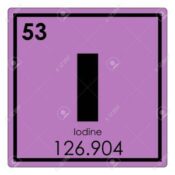Zinc Iodide
Updated July 31, 2023

Iodine Program

This page is under development. Working links will provide starting information. Please let us know about your interest in this page by emailing us here, and check back soon.
From Open AI 7/31/2023
To create zinc iodide by mixing a zinc solution with potassium iodide, you’ll need a water-soluble zinc compound. Zinc chloride (ZnCl2) and zinc sulfate (ZnSO4) are commonly used zinc solutions for this purpose. Both zinc chloride and zinc sulfate are readily available and can be dissolved in water to create a zinc solution.
The chemical reactions with potassium iodide are as follows:
- Zinc chloride: ZnCl2(aq) + 2 KI(aq) → ZnI2(aq) + 2 KCl(aq)
- Zinc sulfate: ZnSO4(aq) + 2 KI(aq) → ZnI2(aq) + K2SO4(aq)
In both reactions, zinc iodide is formed when the zinc solution (either zinc chloride or zinc sulfate) reacts with potassium iodide (KI) in an aqueous environment. The resulting solution will contain zinc iodide, which is not very soluble in water and may precipitate out of the solution as a solid or remain in solution as a complex.
| Anions | Zinc | Potassium | Sodium |
|---|---|---|---|
| Iodide | 172 | 140 | 184 |
| Chloride | 432 | 34.2 | 35.9 |
| Bromide | 106 | 53.5 | 90.5 |
In this table, the anions (iodide, chloride, and bromide) are placed along the top row, while the cations (zinc, potassium, and sodium) are listed in the first column. The solubility values for each combination are provided in the respective cells.



